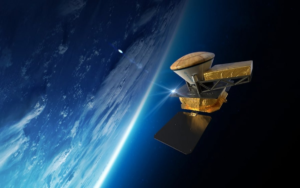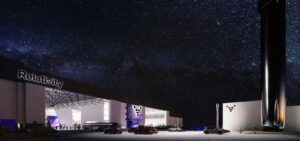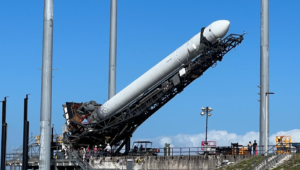
Blue Origin Is Preparing For New Glenn’s Maiden Flight!
It seems each week we are receiving a new Blue Origin update from the company as they get closer to the maiden flight of New Glenn. Usually, they keep most information to themselves, however with the launch approaching, full-scale preparations tend to be much harder to hide and involve massive stages and infrastructure.
Just yesterday we got new images showcasing the structural New Glenn test article moved and raised vertically on the company’s launch site. This comes in addition to all the recent progress with the actual flight hardware and mating of the first and second stages. As of right now, Blue Origin is still planning to launch New Glenn for the first time late this year on a mission to Mars. Here I will go more in-depth into the recent test, its purpose, what it means for the future launch, and more.
New Glenn Is Vertical

Yesterday, the New Glenn structural test article was moved toward the launch site. Not long after it was secured and began going vertical. Finally, pictures provided by NASASpaceflight showed the first stage fully vertical on the pad. As far as what exactly the company was doing, there are a few possible answers.
It’s first important to point out that this specific test article is not the one we saw over the past few weeks. The one that went vertical on the pad is a Pathfinder first stage that is practically hollow. The other New Glenn first and second stage we saw more recently was actual hardware complete with internal tanks and even engines. The last time we saw those specific stages they were being mated inside the nearby hanger. They are probably still there right now undergoing their own testing and fitment.
Focusing back on the vertical New Glenn stage, it mainly helps the company test and prepare certain flight operations. It was designed to be an approximate version of the real deal in both the weight and size department. This way, as seen just yesterday, Blue Origin can test moving it, operations with the transporter erector, general pad work, etc. In this specific instance, the company was most likely trying to get familiar with moving at least part of this massive rocket in preparation for the eventual flight hardware. They would rather test a hollow first stage than a fully complete New Glenn.
The structural article has a few prominent features like four fins at the top. At the same time, it’s missing other aspects such as landing legs and of course engines. These various pieces are simply not needed for the testing they’re completing.
With it matching the actual size of a New Glenn booster, it helps put in perspective how big this launch vehicle is. In total, the rocket is more than 320ft or (98m) tall. The booster while taking up the majority of this height, is still missing the second stage and large fairings which together would extend past the top of the transporter erector.
This testing is a good sign for the overall program and New Glenn’s future. As partially mentioned before, the actual hardware is coming along as well. Not long ago, in a LinkedIn post, CEO David Limp was quoted saying, “While there’s still a lot of work ahead, we’ve recently hit a couple of exciting and visible milestones for our forthcoming New Glenn rocket – and customers entrusting us with their payloads. Our first and second stage hardware have both left the factory and are now at our Launch Complex 36 in Cape Canaveral. That 8-mile drive yesterday was fun to watch, but I am sure stressful for the truck driver and crew” he said. This was specifically referring to the recent rollout.
They then mentioned mating the two stages together. Specifically, they pointed out that this process would allow them to exercise their tooling and stage interfaces. In reality, this is likely the first time they have done this process with capable hardware meaning some of the operations will be new in a way. Assuming the process goes smoothly which is expected, they will have a great baseline and valuable experience to apply before an actual flight attempt. We also know more about the first flight which is far from just experimental.
The Maiden Flight

By now many know that New Glenn’s first flight will carry multiple payloads on a mission to Mars. While ambitious sounding, especially for a maiden flight, it doesn’t quite end there. Ideally, Blue Origin wants the first flight of New Glenn to work from the moment the rocket reaches the pad to when its reusable booster lands back on a barge not long after liftoff. They stress that the inaugural flight will have customer devices on board; it won’t be an experiment. In other words, it seems that not only is Blue Origin planning to try and reach Mars, but also land the booster on the maiden flight. As far as how realistic this is or even if they will have a barge available by then is hard to tell.
We do know that the mission overall is quite risky in the sense that there are a lot of unknowns. Even NASA, which selected the company and launch vehicle for the Mars mission knows this. Originally, NASA awarded Blue Origin a task order to provide launch service for the agency’s Escape and Plasma Acceleration and Dynamics Explorers (ESCAPADE) mission, as part of the agency’s Venture-Class Acquisition of Dedicated and Rideshare (VADR) launch services contract. In the statement, the agency is quoted saying, “ESCAPADE will launch on Blue Origin’s New Glenn rocket from Space Launch Complex-36 at Cape Canaveral Space Force Station in Florida. Launch is targeted for late 2024.”
More relevant when talking about risk, the agency classified this mission as Class D. Looking at a chart provided by the agency, they list four different classifications going from least risky, A, to most risky, D. For Class D missions its quoted saying, “Medium or significant risk of not achieving mission success is permitted. Minimal assurance standards are permitted.”
Bradley Smith, director of NASA’s Launch Services Program, said the agency’s Mars-bound ESCAPADE smallsats will fly on an “incredibly ambitious first launch for (Blue Origin’s) New Glenn” rocket “around this time next year.” He continued by saying, “We will very likely be the very first launch of New Glenn.” To build on this, when talking about the mission risk, Smith said, this is acceptable, since ESCAPADE is what NASA characterizes as a “class D” mission with a higher tolerance for risk. “We’re willing to take a little bit of risk with a price tag and a mission assurance model that reflects that risk” he said. With all this in mind, everyone involved knows that a handful of things could go wrong.
You also have to factor the deadline into the equation. Mars missions only happen every few years due to the orbit relative to Earth. There is a somewhat small window where launches are the most efficient in terms of time to reach the red planet. If New Glenn is not ready in time, they could miss that window and not simply launch a few months late. That being said, there should be an opportunity within a few months in the fourth quarter of this year giving the rocket a bit of room.
In another quote, he said, “There’s certainly some schedule risk associated with New Glenn getting to the pad,” noting he has seen Blue Origin’s schedule for the vehicle but did not disclose details about it. In terms of a specific date, August has been mentioned for ESCAPADE. However, there obviously are a lot of unknowns, and expecting at least some delays is realistic. Even still, a few months would push it back to around December of this year.
For a while now the sentiment has been that Blue Origin could realistically get New Glenn in the air sometime in 2025. That would be initial test flights and would also give time for any errors or problems along the way. You have to consider the New Glenn by itself is a very ambitious vehicle and will include a lot of firsts for the company. Landing the booster out at sea for example will likely take a few attempts before they get it right. On the bright side, they could still theoretically successfully launch the payloads and fail to land the booster. Even though they have some experience with New Shepard, the combination of New Glenn’s size, propulsion, and water landing all complicate the process.
Blue Origin is also aware of this and planning in advance. In a Wall Street Journal report late last year, they confirmed that the company currently has four boosters in production. This means that if a few get destroyed in a failed landing attempt or other error, it won’t be the end of the world.
Currently, it’s clear that Blue Origin is closer than ever to a maiden flight. Even with the occasional update, they are keeping a good portion of information to themselves. General readiness, other test articles, the landing plan, all have for the most part been kept under wraps which could change in the next few months. Leading up to the maiden flight, we should hear even more about what to expect and when. If successful, the rocket could add a major service within the industry. New Glenn’s first stage for example is designed for a minimum of 25 flights. This is supposed to help lead to significantly less waste and cost. It’s planning to be capable of sending more than 13 metric tons to geostationary transfer orbit (GTO) and 45 metric tons to low Earth orbit (LEO). Something we might get to see in the next few years.
Conclusion
Blue Origin is continuing to complete pre-launch preparations with New Glenn. Just yesterday we saw the structural test article moved to the pad and raised vertically to simulate launch operations. We will have to wait and see how it progresses and the impact it has on the space industry.



